Four men, a boat and a Catalina trip that gave me perspective on sailing into midlife
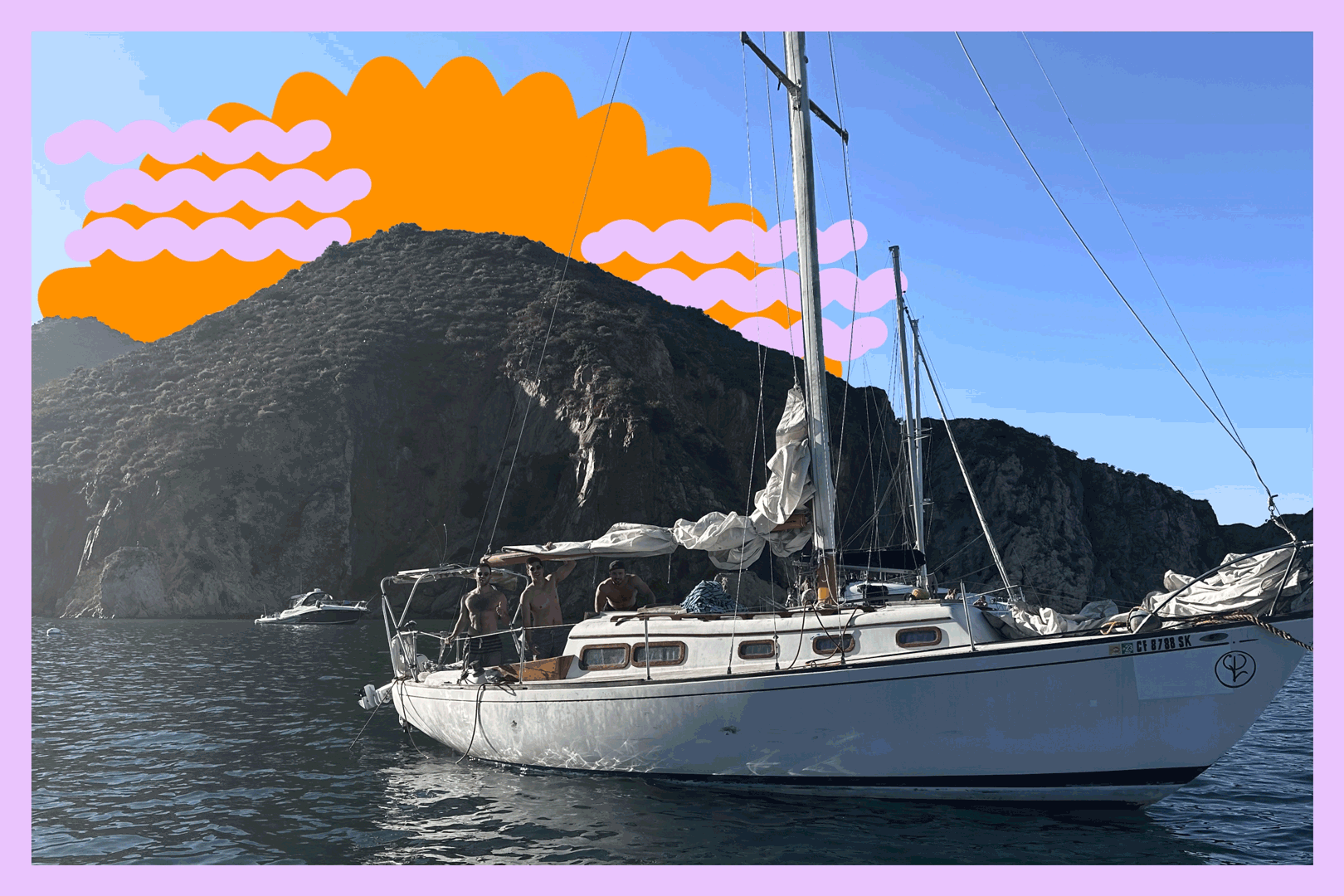
- Share via
Editor’s note: The Wild is all about featuring a variety of exciting voices from SoCal’s outdoors scene. For the next several weeks, we’re featuring guest writers (whom we’ve dubbed “wilders” ) from around The Times who are eager to share their adventures with you. This week’s guest wilder is breaking news reporter Terry Castleman. He’s most likely found zipping around town on an electric moped or gliding across the water on a 50-year-old boat.
Today — the day this newsletter lands in subscribers’ inboxes — is my 30th birthday. To mark the milestone, I’m writing an account of my sailing adventure to Catalina Island — the first first-person piece of my 4½ years at The Times.
Why? Because, as I lurch toward middle age, my biggest fear is the loss of serendipity. Or, more accurately, the loss of opportunities to do something wild and impulsive because of the responsibilities that seem to accrue with each passing year.
It was in service of preserving some of these opportunities for adventure that, three years ago, I purchased a share in a sailboat on Craigslist. Though I had gone to sailing camp as a kid — and even taught rudimentary sailing to campers during my high school years, I had little experience with bigger boats.
Get The Wild newsletter.
The essential weekly guide to enjoying the outdoors in Southern California. Insider tips on the best of our beaches, trails, parks, deserts, forests and mountains.
You may occasionally receive promotional content from the Los Angeles Times.
With her 30-foot monohulled construction, the Charmony was advertised as a “bluewater sailboat,” meaning one that could sail just about anywhere — including the open sea. In fact, in the boat’s 54 years roaming the seas, she had purportedly made numerous trips from Southern California to Central America.
However, like many third-party purchases — Craigslist or otherwise — this one came with complications. Depending on whom you asked, this boat’s motor either worked reliably, unreliably or never. The result was, for the first six months of boat co-ownership, my boat didn’t leave the slip a whole lot. During the interminable nights with handymen of dubious provenance toiling in vain on the motor, I steeled myself with one thought: someday, this boat will take me to Catalina Island. To get there, the boat would need a working motor for navigating harbors and in case the wind failed us.
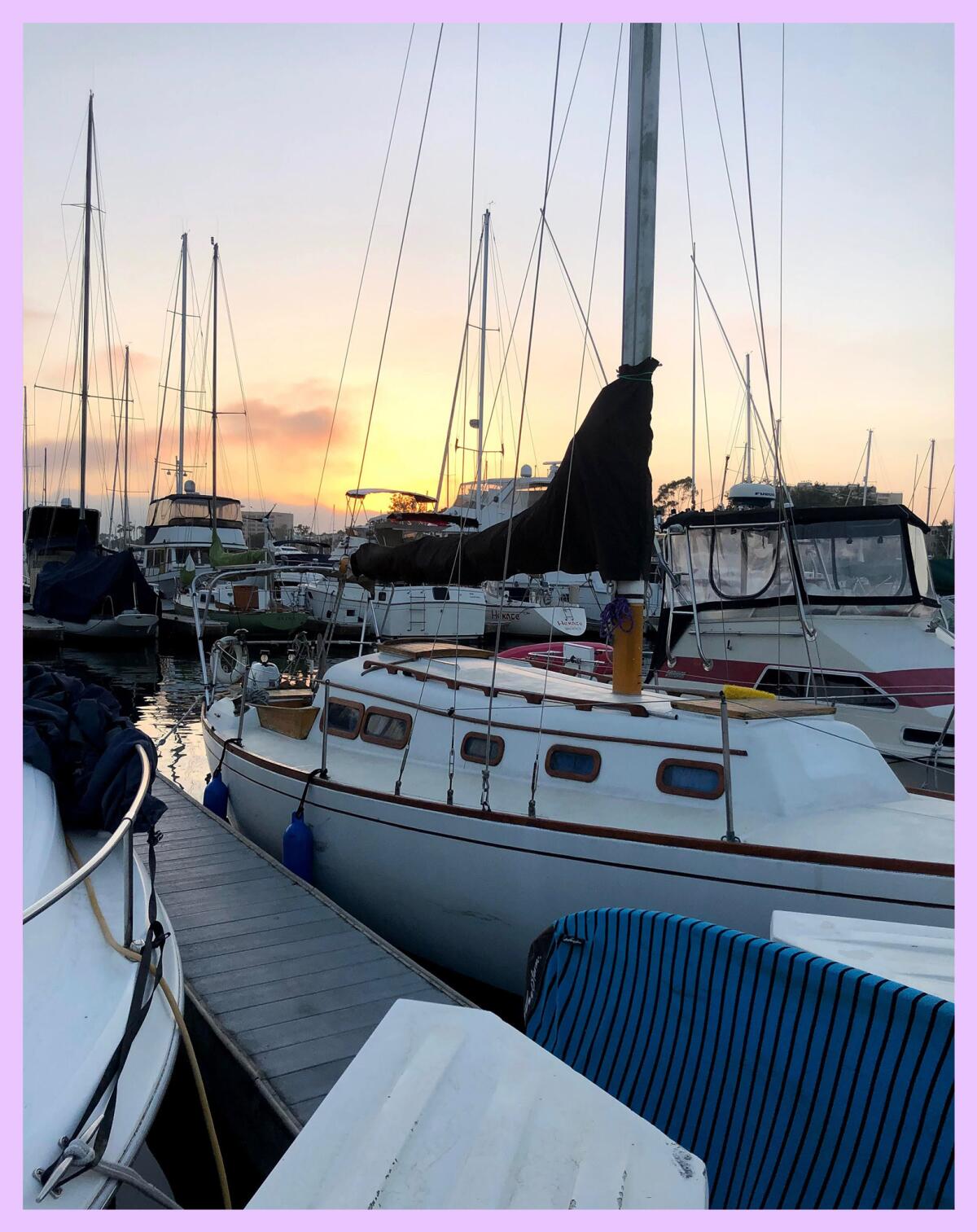
By the time the Charmony partnership agreed to replace instead of repair the motor, I had waited long enough that even a casual cruise out past the Marina del Rey breakwater would be enough. But, like so many sailors since time immemorial, I began to look to the horizon — and Catalina, which sits about 30 nautical miles from Marina del Rey. The journey there, the most common overnight sailing trip from L.A., is the measure of an L.A.-based sailor’s prowess. Given the boat’s advanced age, there were concerns about how well the Charmony would handle the trip and how her crew would fare if an emergency were to arise on the voyage.
The window for optimal weather to make the journey to the island is generally May through September, when the odds of a storm are minimal. In 2021 and 2022, though, my sailing buddies and I either failed to summon the scheduling power or bravery to commit within those two five-month windows.
This year, though, the looming specter of my 30th birthday — and the ever-narrowing opportunities for adventure that seemed to come along with it — added time pressure. So three close friends (one of them another part-owner of the boat) and I settled on a weekend in late August and began to prepare for our voyage.
In my three years of (partially) owning the boat, I had been out for perhaps five or six hours on my longest day of sailing, I had never left the boat anywhere other than in its home berth overnight and I’d never been in charge of a boat on such a long journey. So, as the trip approached, I felt some apprehension, but also anticipation after years of preparation (if pleasure cruises around Santa Monica Bay count as preparation).
On the morning of Saturday, Aug. 26, 2023, my three fellow crewmen and I packed the boat full of supplies — food, camping gear and extra gasoline for our motor — and departed our slip around 10:30 a.m.
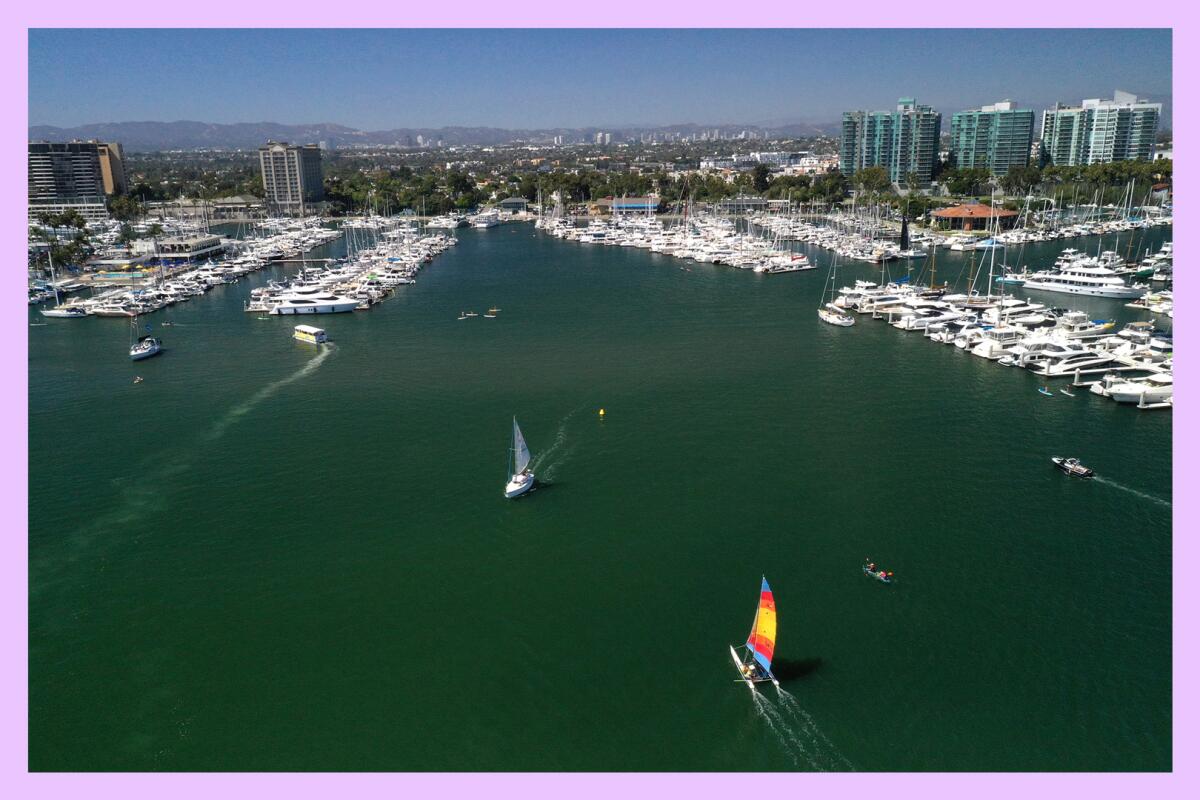
Motoring out of Marina del Rey felt like it had the dozens of other times I’d done it before. With light morning wind, we kept the motor running as we sailed south toward Palos Verdes. Conditions were good, the waters were familiar to us, and we discussed the things that made us nervous about the rest of the day.
First off, we were unsure of whether we could secure a mooring near our campsite since moorings couldn’t be reserved in advance. If we couldn’t get one, we would have to drop several anchors about a hundred yards from shore, which we’d never done for an overnight stay before.
We also shared a general unease about the weather — Tropical Storm Hilary had come through the region just a week earlier — and whether the wind and waves would change. But as we passed the oil tankers off El Segundo into unfamiliar waters, the breeze picked up and the sun shone down.
My colleague Rosanna Xia writes in her indispensable new book “California Against the Sea” that the state’s 1,200 miles of coastline are often grouped together when in reality they consist of countless distinct but interwoven regions. That description came to mind during our one-day journey as we cruised along the coast at 4 knots and identified at least half a dozen distinctly different landscapes.

As we approached the Palos Verdes peninsula, leaving the only bay we’d ever explored with the Charmony, the wind inexplicably dropped off, requiring us to start the motor back up.
After an early afternoon slog past the peninsula, we entered into the San Pedro Channel and were soon sailing along at 6 to 7 knots — our boat’s maximum speed.
Eventually, the island came into view and, byaround 5 p.m., we breathed a sigh of relief as we saw available moorings at the beautiful cove next to our campsite. For $75 a night, we were more than happy to pay for the security of an easy solution instead of fiddling with anchors.
After tying up, we hopped in the water, grinning uncontrollably. We had done it.
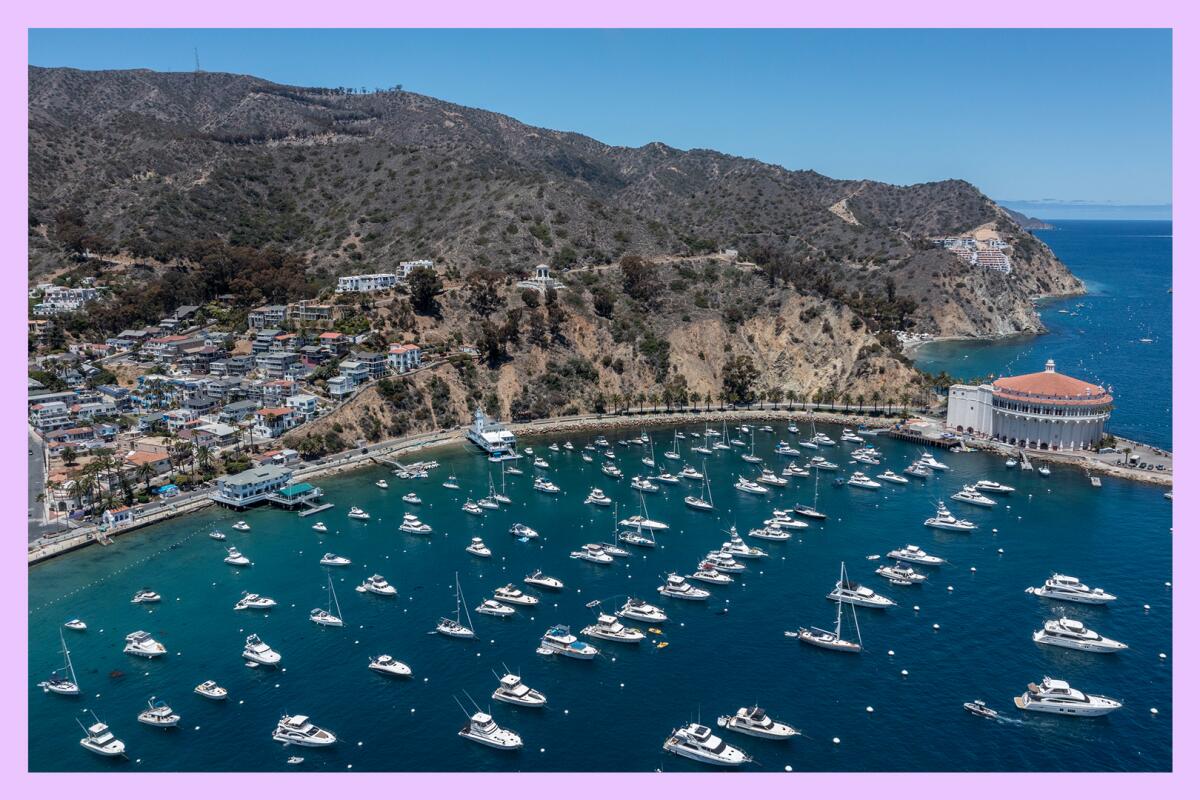
The 6½-hour sail from our slip to Catalina had gone off without a hitch. We had expected it to take longer, but the wind had been our friend. One of my favorite things about sailing is that it necessitates a connection with the wind and waves — it’s very hard to get where you want to go if they aren’t cooperating.
In “California Against the Sea,” Xia writes about how native peoples along the coast understood and respected the power of the ocean before others came and tried to hem it in. Sailing, I believe, forces one to reconnect to that power and to truly pay attention to what the water is saying.
Because my sailing adventure is the main focus of this installment of the Wild, I won’t go into too much detail about our two nights of camping, but during our time we hardly spoke to anyone (outside of our quartet of sailors, at least) and saw all kinds of wild creatures that made the adventure all the more memorable, including a bison, a bald eagle, orange garibaldis and dolphins.
By early Monday morning, it was time to head home. The trip from Catalina to Marina del Rey is upwind and against the current until Palos Verdes, so we knew our return would probably take a few hours longer than our outbound voyage. What we did not expect was a 12-hour odyssey — almost double the amount of time it took us to cover the same distance just a few days before.

By hour 4, when the Palos Verdes peninsula came into view, we were all sunburned and ready to be home as the wind had died down, we were forced to rely on the motor, which, even at its maximum effort, moved us along at just 1 to 2 knots. After our mapping apps reported a grim ETA prediction, we came to terms with the fact that we’d be sailing after dark for the first time.

Dolphins surrounded us at sunset — one of the most beautiful sights I’ve seen in my years of sailing the bay.But it was hard to fully enjoy the moment as my mind — as well as the minds of my fellow sailors — had become fixated on reaching land.
Some 10 hours into our journey home, the last light faded and we continued in darkness toward thenow solitary tanker off of El Segundo. Though the waters were calm and familiar to us, the new sensation of boating at night was a bit unsettling.
Just a mile off the coast, the megalopolis’ light pollution dims enough for a clear view of the stars. Marine life is less disturbed by humans in the dark — seals bark, fish jump — with few boats to interrupt their natural rhythms. And it was only here, with safe arrival all but certain, that we could allow ourselves a moment to enjoy the natural beauty around us.
I’m not going to compare our relief at re-entering the Los Angeles Marina to what Odysseus must’ve felt after his journey. I won’t even compare it to a man in the desert who spots an oasis. But I will say that, after our trip to Catalina, I took a few weeks off from sailing — even though it was still prime summer season.
In this increasingly planned-out and predictable life, even an unpleasant detour can become noteworthy and therefore valuable. Eventually, our bodies will fail us, our social calendars will empty out and we will be left with just our stories.
So, as I sail — literally and figuratively — into my my fourth decade, I hope to find more opportunities to commit to the unexpected and occasionally foolhardy pursuit of adventure.
3 things to do
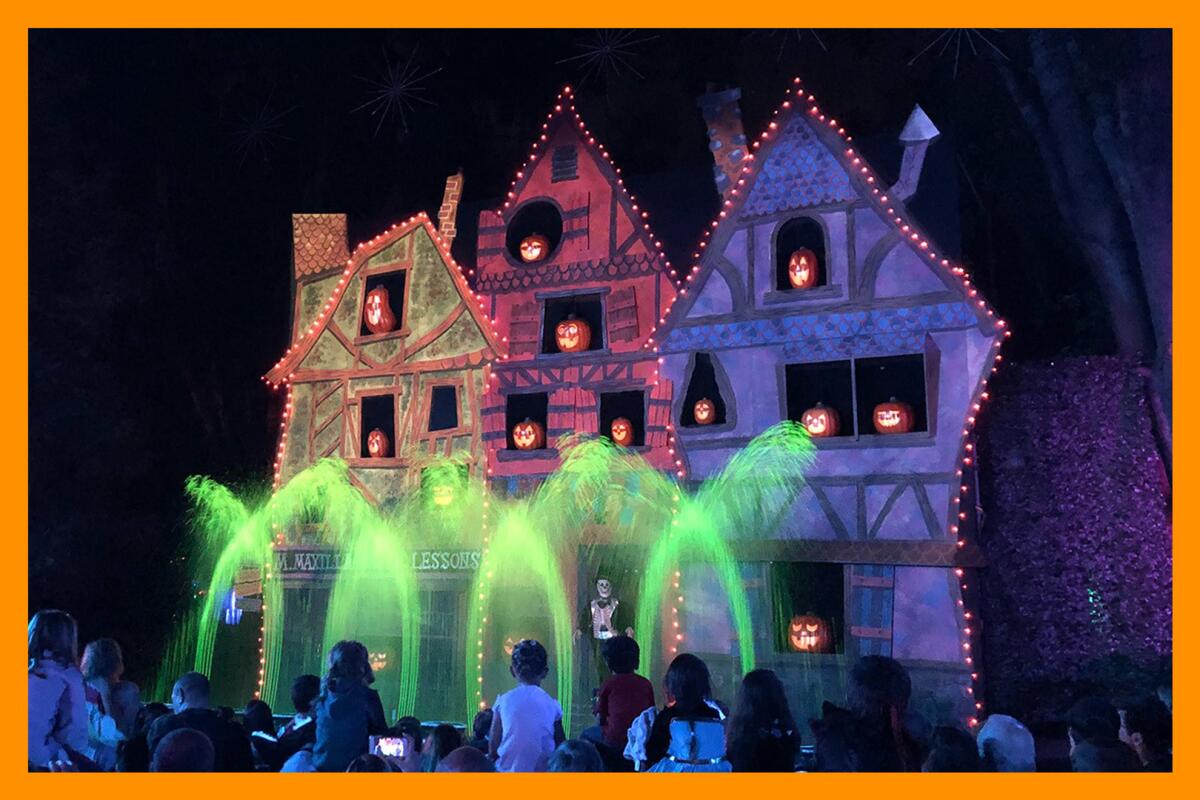
1. Get spooky at the Natural History Museum. Starting today, the museum’s Nature Gardens will be transformed into Boney Island, featuring “ghoulishly glowing exhibits [and] fascinating creatures of the night and prehistoric past.” The event features food trucks, a hot chocolate and cider bar and merch. Open 6 to 10 p.m. Thursday through Sunday, as well as Oct. 30 and 31. Tickets are $25($20 for members). Additional information and tickets at nhm.org.

2. Connect to California’s past at Tomo-Kahni State Historic Park. Guided tours of Tomo-Kahni State Historic Park, located about two hours from Los Angeles, are available every Saturday through October 14. The park is situated on a ridge in the Tehachapi mountains around a Kawaiisu (Nuwa) village and features rock art and other artifacts. Due to the sensitive nature of the site, it can only be visited on guided tours in small groups. The walking tours start at 8:30 a.m., take around three hours and cost $20. Reservations are required and can be made at reservecalifornia.com.

3. Attend a book reading with coastal expert Rosanna Xia. My brilliant colleague is on book tour at the moment, and having attended the Los Angeles reading I can wholeheartedly recommend you attend as well. Her readings feature a deep discussion of coastal issues around sea level rise. In Point Reyes, the event will take place Saturday, Oct. 21, at 4 p.m. at Dance Palace Church Space; in Corte Madera, the reading is scheduled for Sunday, Oct. 22, at 4 p.m. at Book Passage; and in Ojai, you can find her at Bart’s Books on Wednesday, Oct. 25, at 6 p.m.
The must-read
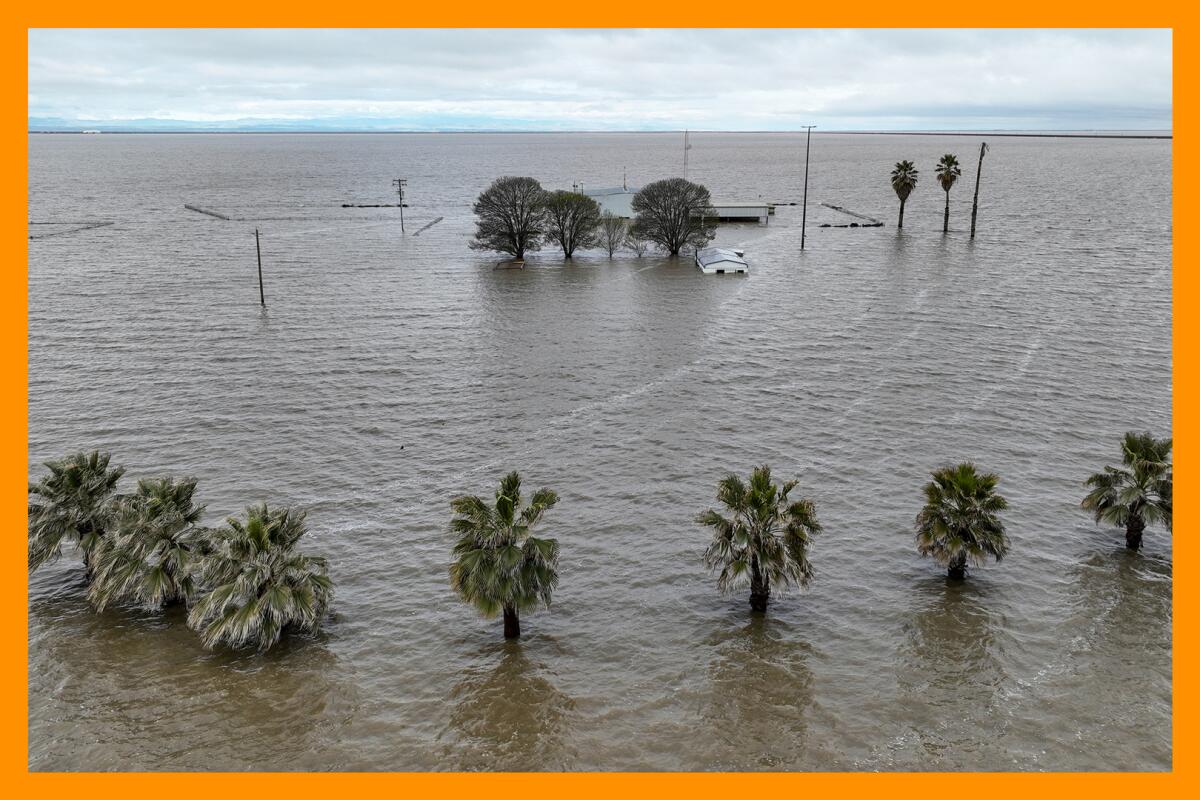
My colleague Hayley Smith is a California water and drought expert. So I take her word for it when she says that another wet winter may be coming thanks to El Niño. Having covered the flooding and devastation wrought by the never-ending series of atmospheric rivers last year, I worry for vulnerable low-lying communities. At the same time, after years of drought, I have enjoyed seeing my home state greener than I can remember it.
Happy adventuring,

P.S.
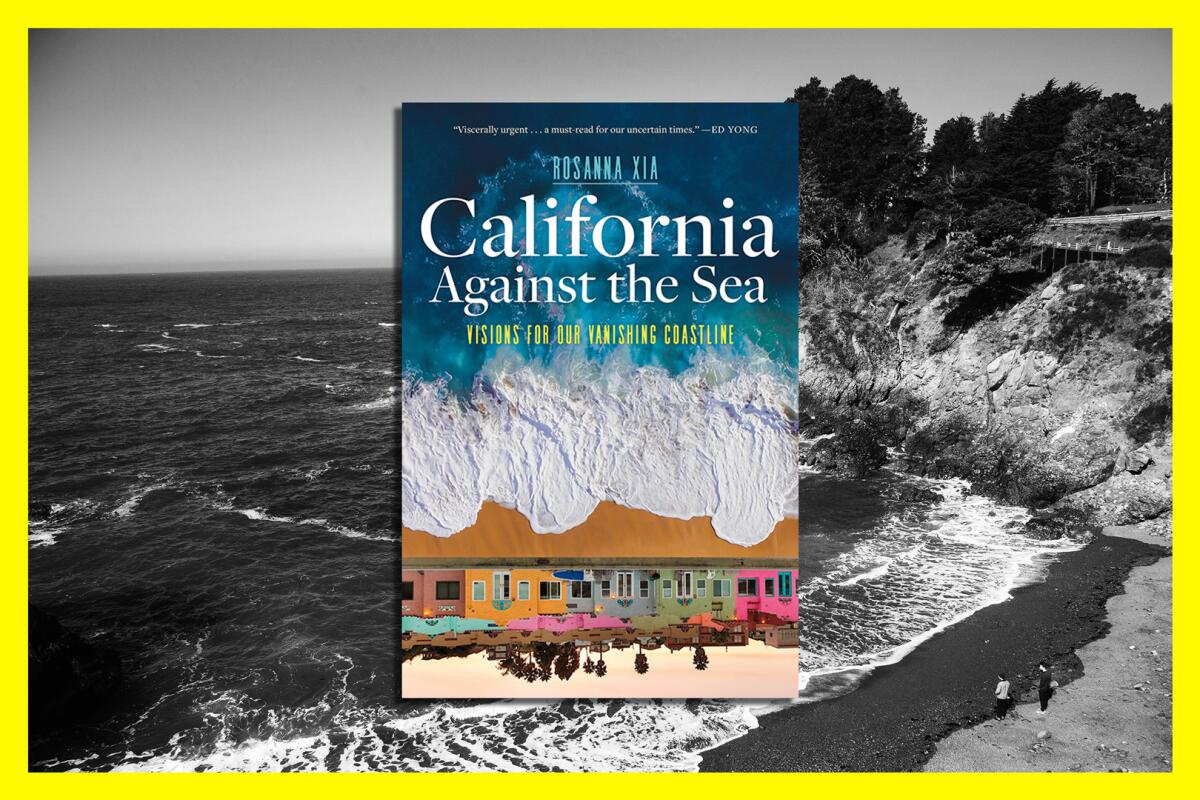
I’ve now mentioned Rosanna Xia’s book several times. My first editorial project at The Times back in 2019 gave me a front-row seat to her incredible work as a reporter covering the California coast. Rosanna directed our then-colleague Swetha Kannan and me as we built out a game based on her reporting on sea-level rise. Over several months, she meticulously guided our every decision.
I remember one draft of the game in which an animated building was one story higher than would be permissible in our fictitious coastal town. Rosanna noticed. We changed it. It’s this same attention to detail and years of knowledge about the coast that make “California Against the Sea: Visions for Our Vanishing Coastline” such an engrossing read. The book moved me viscerally, but perhaps even more on a spiritual level.
I’ve played, surfed and sailed along the coast for most of my life, but it wasn’t until I read Rosanna’s book that I fully examined my own relationship to the Pacific Ocean. I hope you’ll read it too.
For more insider tips on Southern California’s beaches, trails and parks, check out past editions of The Wild. And to view this newsletter in your browser, click here.
Sign up for The Wild
We’ll help you find the best places to hike, bike and run, as well as the perfect silent spots for meditation and yoga.
You may occasionally receive promotional content from the Los Angeles Times.




